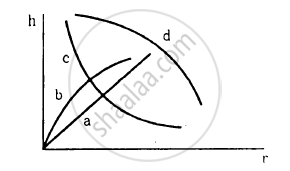Advertisements
Advertisements
प्रश्न
If a drop of liquid breaks into smaller droplets, it results in lowering of temperature of the droplets. Let a drop of radius R, break into N small droplets each of radius r. Estimate the drop in temperature.
उत्तर
When a big drop of radius R, breaks into N droplets each of radius r, the volume remains constant.
∴ Volume of big drop = N × Volume of each small drop
`4/3 πR^3 = N xx 4/3 πR^3`
or `R^3 = Nr^3`
or `N = R^3/r^3`
Now, the change in surface area = `4πR^2 - N4πr^2`
= `4π(R^2 - Nr^2)`
The energy released = T × ΔA
= `S xx 4π(R^2 - Nr^2)` .....[T = Surface tension]
Due to releasing of this energy. the temperature is lowered.
If ρ is the density and s is the specific heat of liquid and its temperature is lowered by Δθ then the energy released = msΔθ ......[s = specific heat Δθ = change in temperature]
`T xx 4π(R^2 - Nr^2) = (4/3 xx R^3 xx ρ)sΔθ` ......`[∴m = vρ = 4/3 πR^3ρ]`
⇒ Δθ = `(T xx 4π(R^2 - Nr^2))/(4/3 πR^3 ρ xx s)`
= `(3T)/(ρs) [R^2/R^3 - (Nr^2)/R^3]`
= `(3T)/(ρs) [1/R - ((R^3-r^3) xx r^2)/R^3]`
= `(3T)/(ρs) [1/R - 1/r]`
APPEARS IN
संबंधित प्रश्न
The energy of the free surface of a liquid drop is 5π times the surface tension of the liquid. Find the diameter of the drop in C.G.S. system.
Explain why Water on a clean glass surface tends to spread out while mercury on the same surface tends to form drops. (Put differently, water wets glass while mercury does not.)
Explain why Water with detergent dissolved in it should have small angles of contact.
What is the excess pressure inside a bubble of soap solution of radius 5.00 mm, given that the surface tension of soap solution at the temperature (20 °C) is 2.50 × 10–2 N m–1? If an air bubble of the same dimension were formed at depth of 40.0 cm inside a container containing the soap solution (of relative density 1.20), what would be the pressure inside the bubble? (1 atmospheric pressure is 1.01 × 105 Pa).
Mercury has an angle of contact equal to 140° with soda lime glass. A narrow tube of radius 1.00 mm made of this glass is dipped in a trough containing mercury. By what amount does the mercury dip down in the tube relative to the liquid surface outside? Surface tension of mercury at the temperature of the experiment is 0.465 N m–1. Density of mercury = 13.6 × 103 kg m–3
Frictional force between solids operates even when they do not move with respect to each other. Do we have viscous force acting between two layers even if there is no relative motion?
Water near the bed of a deep river is quiet while that near the surface flows. Give reasons.
Which of the following graphs may represent the relation between the capillary rise hand the radius r of the capillary?

For a surface molecule ______.
- the net force on it is zero.
- there is a net downward force.
- the potential energy is less than that of a molecule inside.
- the potential energy is more than that of a molecule inside.
When an air bubble of radius r rises from the bottom to the surface of a lake, its radius becomes `(5r)/4`. Taking the atmospheric pressure to be equal to the 10 m height of the water column, the depth of the lake would approximately be ______.
(ignore the surface tension and the effect of temperature)
